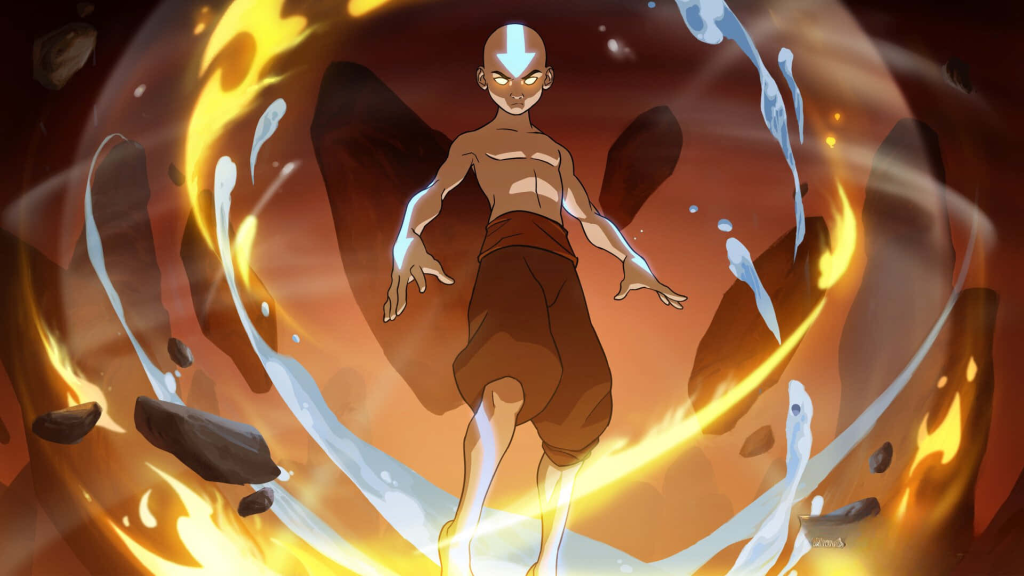Set in a world divided into four nations—Water, Earth, Fire, and Air—Avatar: The Last Airbender follows Aang, a young Air Nomad and the last surviving Airbender, who awakens after being frozen in an iceberg for a century. As the Avatar, Aang is tasked with mastering all four elements to restore balance to a war-torn world ravaged by the Fire Nation’s imperialistic ambitions. Alongside his newfound friends Katara and Sokka from the Southern Water Tribe, Aang embarks on a journey to master waterbending and confront his destiny. Meanwhile, Prince Zuko of the Fire Nation relentlessly pursues him to regain his honor. Themes of redemption, friendship, and resilience drive the narrative as Aang struggles to embrace his responsibilities while maintaining his youthful innocence.

Notable Elements
- Production Design and Visual Effects: The Netflix adaptation features stunning production design that brings the four nations to life with intricate costumes, detailed sets, and impressive CGI for bending battles. The visuals of Aang entering the Avatar State are particularly striking and evoke a sense of awe and danger.
- Performances: Gordon Cormier portrays Aang with a mix of innocence and determination, capturing the character’s playful nature while conveying his inner conflict. Dallas Liu’s Zuko stands out with an emotionally layered performance that highlights his struggle between duty and personal redemption. Kiawentiio Tarbell and Ian Ousley bring warmth and humor as Katara and Sokka, respectively.
- Action Sequences: The bending battles are choreographed with precision, blending martial arts-inspired movements with elemental manipulation. Notable scenes include Aang’s escape from Fire Nation archers and Zuko’s duel against Katara at the Northern Water Tribe.

Themes and Messages
- Balance and Harmony: The story emphasizes the importance of balance—not just in bending but also in relationships between nations. Aang’s journey reflects his quest to harmonize his role as the Avatar with his personal values.
- Redemption and Growth: Zuko’s arc is central to the narrative, showcasing that destiny can be reshaped through personal choices. His relationship with Uncle Iroh serves as a moral compass for change.
- Friendship and Resilience: The bond between Aang, Katara, and Sokka underscores the importance of teamwork and emotional support in overcoming adversity.

Personal Impressions
Netflix’s live-action adaptation of Avatar: The Last Airbender is visually ambitious and emotionally engaging. While it does not fully replicate the charm of the original animated series, it succeeds in reimagining key moments with cinematic flair. Some scenes feel rushed or lack depth compared to their animated counterparts, but the performances—particularly Dallas Liu as Zuko—help ground the story in emotional authenticity. Fans of the original may find certain changes jarring but should approach this adaptation with an open mind.
Audience Recommendations
This film is ideal for fans of fantasy adventure stories who enjoy rich world-building and character-driven narratives. Viewers unfamiliar with the original series will find it an accessible entry point into Aang’s epic journey.
Conclusions and Ratings
Avatar: The Last Airbender is a commendable attempt at adapting a beloved animated series into live-action format. While it faces challenges in meeting fans’ expectations, its strong performances and visual achievements make it worth watching. I would rate it 4 out of 5 stars.
Trailer on YouTube
Watch the official trailer for Netflix’s Avatar: The Last Airbender here:
Images:
- Aang in Action: A still of Gordon Cormier as Aang entering the Avatar State during a battle sequence.
- Zuko’s Redemption Arc: An image of Dallas Liu as Zuko confronting Uncle Iroh about his destiny.
- Northern Water Tribe Setting: A breathtaking shot showcasing the icy landscapes where Aang trains under Master Pakku.